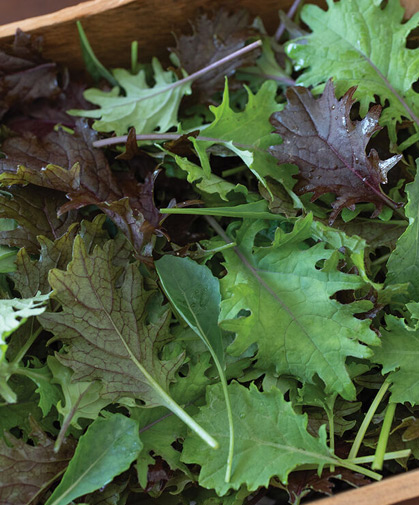- Vegetable Amaranth | Key Growing Information
- Salad Mix Collection | Tech Sheet (PDF)
- Baby Leaf Greens | Variety Comparison Chart (PDF)
- Video: Baby Leaf Greens: 12 Picks for Market Growers | Johnny's Webinar Series
- Baby Leaf Lettuce | Variety Comparison Chart (PDF)
- Arugula | Key Growing Information
- Cress Greens: Watercress & Upland Cress | Key Growing Information
- Malabar Spinach | Key Growing Information
- Baby Leaf Greens: 12 Picks for Market Growers | Johnny's Educational Webinar Resources
- Jang Seeder: How to Maximize Its Potential | Johnny's Educational Webinar Resources
- Baby Leaf Greens & Baby Leaf Lettuce | Technical Production Guide
- Salad Mixes | Key Growing Information
- Purslane (Portulaca oleracea sativa) | Key Growing Information
- Greens for All Growers | A 3-Tiered Approach to Production & Marketing
- Baby Leaf Swiss Chard | Key Growing Information
- Spinach | Key Growing Information
- Baby Leaf Beet Greens | Key Growing Information
- Claytonia | Key Growing Information
- Salad Mixes & Microgreens Mixes | 2-pp Spec Sheet (PDF)
- Baby-Leaf Chicory | Key Growing Information
- Video: Baby Leaf Harvester for Greens, Mesclun, Spinach, Lettuces & Tender Aromatics
- Sorrel | Key Growing Information
- Baby-Leaf Brassica Greens | Key Growing Information
- Baby Leaf Harvester | Instructions for Safety, Assembly, Operation & Maintenance | Tech Sheet (PDF)
- Video: Jang Seeder: How to Maximize Its Potential | Johnny's Webinar Series
- Mâche/Cornsalad | Key Growing Information
Baby-Leaf Brassica Greens - Key Growing Information

SCIENTIFIC NAME:
This growing information is for baby-leaf production of the following Brassicas, including baby mustard greens, mizuna, tatsoi, and komatsuna: Brassica carinata, B. juncea, B. napus ('Red Russian' and 'KX-1'), B. rapa, B. rapa var. chinensis ('Tokyo Bekana' and 'Rosie'), B. rapa var. japonica, B. rapa var. narinosa ('Tatsoi'), B. rapa var. perviridis ('Green Giant').CULTURE:
Brassicas prefer soil with a pH of 6–7.5 and can be grown all season in the field. Most varieties are hardy enough to grow in cool greenhouses and high tunnels during winter from late summer and early fall sowings. DAYS TO MATURITY: From emergence after direct seeding.DIRECT SEEDING:
Sow ¼" deep at 3–5 seeds/inch, in rows at least 2" apart from early spring into midsummer. Can be sown into late fall if overwintering in a high tunnel or other protected structure.RECOMMENDED JANG SEED ROLLER (baby leaf): Mustard, Mizuna, Pac Choi, Tatsoi: Y-24 or X-24; Chinese Cabbage, Kale, Komatsuna: X-24 or F-24. (Where multiple rollers are recommended, choosing a roller with a larger hole will increase the number of plants per inch. This creates longer petioles and somewhat slower-growing, narrower leaves for an extended baby leaf harvest. It will also wash out color, hasten bolting, and increase the need for water and fertility. Choosing what works best for your system may take some trialing and adjustment.)AVG. DIRECT SEEDING RATE: For Mizuna, Tatsoi, Komatsuna, and Pac Choi: 1 oz./210', 1 lb./3,300'. For Kale: 1,000 seeds/16', 1 oz/115', 1 lb./1,840'. For Mustard: 1 oz./260', 1 lb./4,160'.

